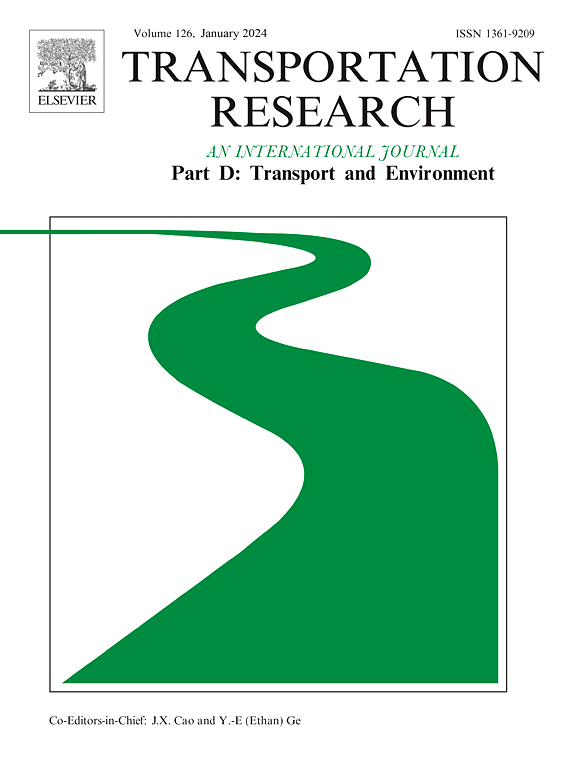轻型柴油车在实际驾驶条件下的氮氧化物减排方案
IF 7.3
1区 工程技术
Q1 ENVIRONMENTAL STUDIES
Transportation Research Part D-transport and Environment
Pub Date : 2024-10-17
DOI:10.1016/j.trd.2024.104467
引用次数: 0
摘要
本研究分析了严格的排放法规对未来氮氧化物减排的影响。通过情景分析,利用实际驾驶排放数据中的排放因子,估算了 2019 年至 2040 年柴油轻型车辆的氮氧化物排放量。基准情景假定现行法规将保持不变,而其他情景则评估作为最终法规实施特定欧洲标准的影响。如果到 2040 年实施欧 5 法规,累计排放量将比基准情景增加 229.1%。实施欧 6 a/b/c 法规将增加 156.2%,而欧 6 d-temp 和欧 6 d 法规将分别增加 8.4% 和 0.7%。这些研究结果凸显了欧 6 d-temp 引入的实际驾驶排放测试对减少氮氧化物的重大贡献。此外,这些结果还表明,欧 6 d 法规已经达到了与即将实施的欧 7 法规类似的排放水平。本文章由计算机程序翻译,如有差异,请以英文原文为准。
NOx reduction scenarios under real-world driving conditions for light-duty diesel vehicles
This study analyze analyzes the impact of stringent emissions regulations on future NOx reductions. Using scenario analysis, NOx emissions of diesel light-duty vehicles from 2019 to 2040 are estimated using emission factors from real driving emissions data. The baseline scenario assumes current regulations will be maintained, while other scenarios assess the impact of implementing specific Euro standards as final regulations. If Euro 5 regulations are implemented by 2040, cumulative emissions will increase by 229.1 % compared to the baseline scenario. Implementing Euro 6 a/b/c regulations will increase by 156.2 %, while Euro 6 d-temp and Euro 6 d regulations will increase by 8.4 % and 0.7 %, respectively. These findings highlight the significant contribution of real driving emission test introduced with Euro 6 d-temp to NOx reduction. Furthermore, they indicate that Euro 6 d regulation has already achieved emission levels similar to those of the upcoming Euro 7 regulation.
求助全文
通过发布文献求助,成功后即可免费获取论文全文。
去求助
来源期刊
CiteScore
14.40
自引率
9.20%
发文量
314
审稿时长
39 days
期刊介绍:
Transportation Research Part D: Transport and Environment focuses on original research exploring the environmental impacts of transportation, policy responses to these impacts, and their implications for transportation system design, planning, and management. The journal comprehensively covers the interaction between transportation and the environment, ranging from local effects on specific geographical areas to global implications such as natural resource depletion and atmospheric pollution.
We welcome research papers across all transportation modes, including maritime, air, and land transportation, assessing their environmental impacts broadly. Papers addressing both mobile aspects and transportation infrastructure are considered. The journal prioritizes empirical findings and policy responses of regulatory, planning, technical, or fiscal nature. Articles are policy-driven, accessible, and applicable to readers from diverse disciplines, emphasizing relevance and practicality. We encourage interdisciplinary submissions and welcome contributions from economically developing and advanced countries alike, reflecting our international orientation.

 求助内容:
求助内容: 应助结果提醒方式:
应助结果提醒方式:


